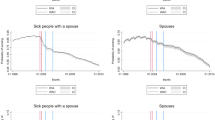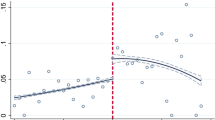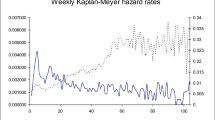Abstract
This paper studies a specific type of moral hazard that arises in the interplay between two large public social insurance systems in Sweden, namely the sickness insurance (SI) and the unemployment insurance (UI). Moral hazard can arise from the structure of the benefit levels as for some unemployed persons benefits from the SI are higher than benefits from the UI. We use a reform of the SI system that came into force on 1 July 2003 to identify the effect of economic incentives arising from the different benefit levels. The purpose of the reform was to eliminate the difference in benefits between the two social insurance systems. Our results from a duration analysis show clearly that the higher the sickness benefits, the higher the probability of reporting sick.
Similar content being viewed by others
References
Ai D, Norton EC (2003) Interaction terms in logit and probit models. Econ Lett 80: 123–129
Carling K, Edin P-A, Harkman A, Holmlund B (1996) Unemployment duration, unemployment benefits and labor market programs in Sweden. J Public Econ 59: 313–334
DeLong DM, Guirguis GH, So YC (1994) Efficient computation of subset selection probabilities with application to Cox regression. Biometrika 81: 607–611
Edin P-A, Fredriksson P (2000) LINDA—longitudinal individual data for Sweden. Working Paper 2000-19, Department of Economics, Uppsala University
European Economic Advisory Group (2007) Report on the European Economy 2007. Ifo Institute for Economic Research
Henningsen M (2007) Benefit shifting: the case of sickness insurance for the unemployed. Labour Econ 15: 1238–1269
Johansson P, Palme M (2004) Moral hazard and sickness insurance: empirical evidence from a sickness insurance reform in Sweden. Working Paper 2004-10, IFAU
Johansson P, Palme M (2005) Moral hazard and sickness insurance. J Public Econ 89: 1879–1890
Kalbfleisch J, Prentice R (1980) The statistical analysis of failure time data. Wiley, New York
Katz L, Meyer B (1990) The impact of the potential duration of unemployment benefits on the duration of unemployment. J Public Econ 41: 45–72
Krueger A, Meyer B (2002) Labor supply effects of social insurance. In: Auerbach A, Feldstein M (eds) Handbook of public economics, vol 4. Elsevier, Amsterdam
Larsson L (2004) Harmonizing unemployment and sickness insurance: why (not)?. Swedish Econ Policy Rev 11(1): 151–188
Larsson L (2006) Sick of being unemployed? Interactions between unemployment and sickness insurance in Sweden. Scand J Econ 108: 97–113
Lindeboom M, Kerkhofs M (2000) Multistate models for clustering duration data—an application to workplace effects on individual sickness absenteeism. Rev Econ Stat 82: 668–684
Meyer B (1990) Unemployment insurance and unemployment spells. Econometrica 58: 757–782
Moffitt R (1985) Unemployment insurance and the distribution of unemployment spells. J Econom 28: 85–101
Pettersson-Lidbom P, Skogman Thoursie P (2006) Temporary disability insurance and labor supply: evidence from a natural experiment. Mimeo (version 31 March 2006), Department of Economics, Stockholm University
Puhani P (2008) The treatment effect, the cross difference, and the interaction term in nonlinear “difference-in-differences” models. IZA Discussion Paper No. 3478
Ridder G, Tunali I (1999) Stratified partial likelihood estimation. J Econom 92: 193–232
Van den Berg G (2001) Duration models: specification, identification, and multiple durations. In: Heckman J, Leamer E (eds) Handbook of Econometrics, Vol 5. North-Holland, Amsterdam
Author information
Authors and Affiliations
Corresponding author
Rights and permissions
About this article
Cite this article
Hall, C., Hartman, L. Moral hazard among the sick and unemployed: evidence from a Swedish social insurance reform. Empir Econ 39, 27–50 (2010). https://doi.org/10.1007/s00181-009-0293-7
Received:
Accepted:
Published:
Issue Date:
DOI: https://doi.org/10.1007/s00181-009-0293-7




